HOWTO:Bi-directional Signals
Contents
Philosophy
The question often arrises about bi-directional signal types (those that either could be a source or a destination or those that carry a transmit and receive signal in the same cable structure). How do we create ports for these types of signals? The short answer is that WireCAD does not care whether you place a port on the lefthand side or the righthand side of a functional block. We use the inputs on the left and outputs on the right by convention only. So what does that mean to you? It all comes down to document flow. Will your document read better if you place the port on the lefthand side or the righthand side.
Examples
RS-422
Consider that we have an RS-422 signal with a controlling device and a device under control:
We may place the RS-422 port on the righthand side of the controlling device and the RS-422 port on the lefthand side of the device under control. This would facilitate a left to right read of our document.
ETHERNET
Consider that we have a network that includes a router, switch, and workstations:
We may place the ports in either of these configurations:
And of course, there is nothing stopping you from adding the port to both sides and then selecting the port configuration that best suits your needs at the time.

